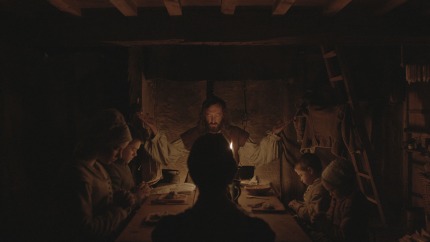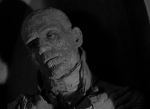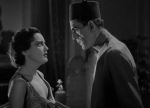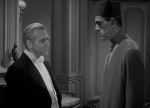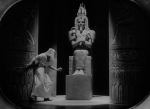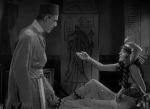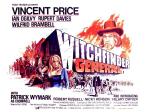
Today’s cinema adventure: An American Werewolf in London, the 1981 comedy-horror film by John Landis, about a young American who survives an attack by a mysterious assailant while backpacking through England, only to find that he has become cursed to transform into a monster by the light of the full moon. A quirky mix of madcap humor and gruesome horror, it was a fairly respectable hit upon its release, despite mixed reviews, and has since become something of a cult classic. It was particularly notable for its then-groundbreaking make-up effects, which garnered their creator, Rick Baker, the first-ever Academy Award in the new category created to honor such work.
The movie opens on the moors of Northern England, where two young American friends, David and Jack, are on the first leg of a European hiking tour. Arriving at nightfall in a remote village, they decide to stop off at the town pub in order to get some rest and sustenance. The locals view them with suspicion, and when Jack asks about a strange 5-pointed star carved into the wall, they become downright hostile; the two young men decide to leave, and though they are warned to stick to the roads they soon become lost on the moor. Things get much worse when they realize they are being stalked by a mysterious animal; when they try to run, it abruptly attacks them, savagely killing Jack and mauling David before the villagers arrive and shoot the beast dead as the young traveler loses consciousness. He wakes up some days later, in a London hospital, where he has been sent by the locals to recover from his injuries. The physician, Dr. Hirsch, and the attending nurse, the lovely Alex, are kind and sympathetic, but their young patient is troubled by the villagers’ official report that he and Jack were attacked by an escaped lunatic and not a ferocious animal. Though the police put little stock in his traumatized memories, Dr. Hirsch decides to do a little further investigation on his own; meanwhile, David strikes up a relationship with Nurse Alex, moving in with her upon his release from the hospital. Their romance is blissfully therapeutic, despite the young man’s troubling, violent nightmares; but harder to ignore are the visits from the increasingly decomposed ghost of his unfortunate friend Jack, who claims that they were actually attacked by a werewolf, and that David is now a werewolf himself. Worse yet, Jack and all the other victims of the monster’s bloodthirsty rage are doomed to wander the earth until their killer’s bloodline has been severed- meaning that David, as the last surviving carrier of the curse, must die before the next full moon can transform him into a ravenous beast and lead to more senseless slaughter. Though David is skeptical of the warnings, Hirsch is sufficiently convinced by a visit to the moors that his former patient may be a danger to himself and others, and he joins forces with Alex in an attempt to protect the young man from the darkness- whether supernatural or psychological- that threatens to take control of his destiny.
As written by Landis, who was inspired over a decade earlier when he witnessed a group of Central Europeans performing a ritual to prevent a deceased fellow villager rising from his grave, this grim and familiar tale is laced with the kind of hip, contemporary humor that marked the youth-oriented films of the period; arch, ironic, tongue-in-cheek, and self-referential, the comedy is a major ingredient in the mix, but Landis stops short of letting it undermine the gravity of his horror story. It seems an odd juxtaposition, and many critics were at a loss to reconcile the seeming opposition of the movie’s two aspects; nevertheless, the apparent cross purposes complement each other in a way that makes for a unique and highly entertaining ride. In addition, the two cultural sensibilities reflected in the film’s title are brought into the equation through the film’s overall style; the flip jocularity of the American mindset is superimposed against a background of traditional English influences that resembles a blend of Hammer horror and the Carry On series, with a slight dash of Monty Python thrown in for good measure. The resulting subtextual implication in which the youthful, callow naïveté of the distinctly American personality is thrust into the Old World subtlety of European experience, suggests a story that is ultimately, perhaps, about the dangers of being overconfident in a world that is deeper and more complex than we know.
That’s not to propose that Landis’ purpose here involves any kind of socio-political statement; the “babe in the woods” undercurrent, extrapolations about cultural identity aside, serves mainly as a foundation for the uneasy sense of foreboding that pervades the film from its opening frames, when the hazy atmosphere of the isolated moors seems pregnant with ominous possibility and fills us with the dread of something unknown, lurking just beyond the hills or, perhaps, hiding in plain sight. Confronted from the start with this landscape that is at once familiar and alien, we immediately bond with the two fresh-faced adventurers who, a few moments later, arrive on the scene- in a truck full of sheep, like proverbial lambs to the slaughter (to reinforce this idea, the pub through which they will soon begin their descent into horror is called “The Slaughtered Lamb”). We are charmed by their banter, comfortable in their camaraderie, and touched by their friendship; we share their bemused outsiders’ perspective because we, too, are outsiders here, a commonality that helps us identify with them, but because they are so endearing, we also genuinely like them. It is this factor, cannily accomplished by Landis in his script, that makes us cringe at a deeper level when they become victims of the inevitable carnage; and with this foundation laid, as the film follows the subsequent adventures of David, despite the cheeky comic tone maintained throughout, we can never quite escape or ignore the soul-sickening undercurrent of sadness which pursues us to the end.
Landis is able to pull off this delicate balance largely because he seems unconcerned with pre-conceived limitations of genre; as the director of the wildly popular Animal House and The Blues Brothers, he was the undisputed master of the kind of irreverent and iconoclastic humor that is on display in American Werewolf, and he confidently delivers the same lampooning style in his approach. There is a definite anti-establishment flavor here that is cut from the same cloth as those earlier films, manifested in a continual opposition between stodgy decorum and free-spirited permissiveness. The guarded discretion of the villagers regarding their town’s dark secret, the by-the-book attitude of the bumbling policemen assigned to de-brief David, and the stiff-upper-lip dispassion of Dr. Hirsch and even Nurse Alex as they become more deeply involved with their patient; all these are contrasted with the repeated disregard for rules of behavior displayed by the young Americans. Jack and David challenge local custom with their questions in the pub, and later on, David flies against procedural form with passionate protests regarding the truth about his attacker on the moors, and he skirts propriety by crossing professional boundaries to initiate a relationship with his nurse; it is a similar lack of concern for the rules that allows Landis to blur the lines between comedy and horror with such disarming audacity. In a way, it is as if he is attacking repressive authority on multiple fronts; not only does he sideswipe convention and cliche with satirical absurdity, and disturb order and decorum with gruesome violence, he also flaunts conservative standards of decency with a high level of sexual frankness and pointedly gratuitous nudity.
An American Werewolf in London uses all these ingredients, ultimately, in the service of providing entertaining thrills for the youth audience at which it was targeted. The hip, comedic tone and the willful exploitation of sex and violence create an appealingly loose, edgy atmosphere, but it is the narrative itself that keeps us hooked, and Landis the director handles it skillfully. The leisurely opening sequence is a small masterpiece in itself, and could stand on its own as a fine short film; the jocularity of the protagonists is slowly overtaken by the undercurrent of menace in a textbook example of building tension through visual storytelling. As the tale progresses, we are subjected to alternating moments of hilarity and terror, often spiking one with the other, keeping us off balance at a visceral level while Landis fills the screen with artfully arranged variety of culturally telling details, from the recurring ironic presence of a Mickey Mouse figurine to the ludicrous porno send-up being shown at the cinema where David has his final meeting with Jack. Along the way he continues to build on our emotional connection to David (as well as to Alex and, to a lesser extent, Dr. Hirsch, who become his allies) and offers up numerous stylish set pieces- a handful of nightmare sequences, a zany romp at the London Zoo, a gripping predator-and-prey chase in a “tube” terminal, an erotically-charged love scene between David and Alex in the shower- until he reaches the climax, an over-the-top blow-out of carnage and confusion in Piccadilly Circus that plays like a deadly slapstick farce. Up until this point, his recipe works; the excesses of the finale somehow push the limits of plausibility to the breaking point, and the callousness with which he treats the deaths of all these innocent bystanders feels a little too mean-spirited to be excused under the license of black comedy. The final tragic confrontation which closes the film, a forgone conclusion since the very first frame, is also, undeniably, a bit of a letdown, and the promising potential for emotional payoff remains unrealized; it’s as if Landis, who has expertly managed to pad out what is essentially a familiar and simple scenario with clever distractions, has reached the bottom of his bag of tricks and decided to end his movie by hurriedly delivering the expected ending with as little fuss as possible. Despite this anticlimax, however, Landis’ has invested enough into his main characters, on a deeper level than the snarky disaffection of the movie’s surface, to leave us in a state of satisfied melancholy as the end credits roll, and though we may have wished for an worthier ending for his clever mash-up, it must be admitted that his effort to present an oft-told tale in a fresh and surprising package has been, on the whole, a success.
A good deal of that success deserves to be credited to the charm of Landis’ leading players; in particular, of course, the considerable appeal of his star, David Naughton, whose earlier career as a pitchman for Dr. Pepper had made him a familiar face for most audiences, contributes significantly. Attractive, affable, sincere, and possessed of a devilishly sly but somehow wholesome quality that makes him both sexy and endearing, his personality is well-suited to the demands of both the lightweight and dramatic aspects of American Werewolf, and watching him here makes us regret that, for whatever reason, he failed to become the rising star that his talent seemed to promise. Matching him well is the beautiful Jenny Agutter, another familiar face (Logan’s Run¸ Equus) who never quite achieved full stardom, at least in the U.S., as Alex; she carries the same, sweet-but-sexy aura as her leading man, with an added layer of maturity and intelligence that makes her far more interesting than the standard damsel-in-distress usually found in monster movies. John Woodvine is witty and refreshingly likable in his role as the benevolent older authority figure, Dr. Hirsch, and the assortment of recognizable English actors that constitute the cadre at the “Slaughtered Lamb” do a fine job of infusing life and dimension into the stock “superstitious villagers” characters that they represent. The standout performance, though, comes from Griffin Dunne, as the doomed Jack; his lovably nebbish, self-deprecating nerd persona provides a perfect complement to Naughton’s all-American boy, and the chemistry they share is tangible- a factor that helps to add resonance to later developments when the deceased Jack returns to haunt his best friend. Dunne manages, in those scenes, to bring the likable humanity of his character to the forefront despite the progressively hideous make-up he wears, undercutting the body horror of his walking-dead image with wit, pathos, and personality.
On the subject of the make-up, the aforementioned Rick Baker- whose prolific work in this field has always helped to redefine and push the limits of the craft- leads the pack in terms of kudos for Landis’ technical crew. Not only do his remarkably detailed and gruesome prosthetic creations make for an utterly convincing conversion of Dunne into a grisly walking corpse, his work with Naughton’s transformation sequence, in which the handsome actor becomes the fearsome title creature, is a ground-breaking display of wizardry; a far cry from the old stop-motion effects used to morph Lon Chaney, Jr. in the classic Universal Wolf Man and its sequels, it is a truly hair-raising (literally and figuratively) pre-CG spectacle that reminds us all that movie magic did not begin with the computer age. Also noteworthy is the cinematography by Robert Paynter, capturing the character and mood of the numerous English locations, from the desolate moors to the garish lights of Piccadilly, with a richness that gives weight to the proceedings; again, it’s a reminder of a now-bygone time, before the distinctive visual quality created by photography on actual film was supplanted by the high-definition digital imaging that dominates cinema today. Finally, Landis gives his film a soundtrack that is comprised partly of effectively unsettling original scoring by veteran composer Elmer Bernstein, and partly of a rather tongue-in-cheek selection of various popular recordings linked together by the subject of the moon, with several varied renditions of the standard, “Blue Moon,” Creedence Clearwater Revival’s “Bad Moon Rising,” and Van Morrison’s “Moondance,” each figuring prominently in highly memorable sequences.
An American Werewolf in London is another one of those films that figured prominently in my own younger years; I have fond memories of seeing it, multiple times, on the big screen, and there was a time when I could quote virtually every line of dialogue. In the ensuing years I assumed that my youthful enthusiasm, coupled with a fondness for monster movies and all things English, had probably paid a large part in my enjoyment of a film which, really, was little more than pulp cinema. Upon my recent viewing, I was pleasantly surprised to discover that, in fact, Landis’ odd little film holds up extremely well, and, in fact, boasts many nuances- some of which are explored above- that I had not previously recognized. It’s really a tight, stylish, and yes, classy movie; though it deliberately strives for the lurid, sensational atmosphere of both Hollywood exploitation cinema and British “penny dreadfuls,” and it offers up a considerable amount of nudity, sex and violence (the gory, nightmarish kind so gleefully proffered by the blood-spattered horror films produced in England throughout the ‘60s and ‘70s), it nevertheless maintains an elegant, restrained sensibility, suggesting far more than it shows and allowing the audience’s imagination to fill in a lot of the blanks. Landis, for all his excess, does himself credit in his handling of the werewolf and its reign of terror, giving us only brief glimpses of the beast itself and using cinematic artistry- sound, camera perspective, editing- to build the suspense and fear; of course, we would feel cheated if he didn’t also deliver some good old blood-and-guts, and he gives us just enough of those to make us happy (if that’s the right word), but its also to his credit that we walk away feeling as if we’ve seen much more of a bloodbath than we actually have. In the end, though, American Werewolf is most truly memorable for its unique hybrid personality, which lets us laugh, cringe, and cry a good deal more than we might expect. It’s a smart, sexy, and surprisingly affecting film that has aged well, which is more than can be said for many of the more lauded-at-the-time works from the period. Though it may not, at the time, have been as highly esteemed as Landis’ previous hits (mentioned above), and though, for many, his most important and lasting creation will always remain his video for Michael Jackson’s “Thriller,” An American Werewolf in London may well, in truth, be his best work as a filmmaker; at the least, it’s a definite crowd-pleaser, guaranteed to evoke a grin and a grimace from even the most hardcore horror buff.
http://www.imdb.com/title/tt0082010/



























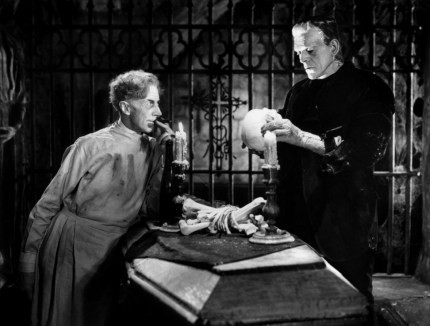
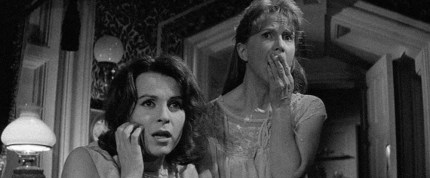 “The Haunting” (1963) – Even if seems tame by today’s standards, director Robert Wise’s adaptation of a short novel by Shirley Jackson is still renowned for the way it uses mood, atmosphere, and suggestion to generate chills. More to the point for LGBTQ audiences is the presence of Claire Bloom as an openly lesbian character (Claire Bloom), whose sympathetic portrayal is devoid of the dark, predatory overtones that go hand-in-hand with such characters in other pre-Stonewall films. For those with a taste for brainy, psychological horror movies, this one is essential viewing.
“The Haunting” (1963) – Even if seems tame by today’s standards, director Robert Wise’s adaptation of a short novel by Shirley Jackson is still renowned for the way it uses mood, atmosphere, and suggestion to generate chills. More to the point for LGBTQ audiences is the presence of Claire Bloom as an openly lesbian character (Claire Bloom), whose sympathetic portrayal is devoid of the dark, predatory overtones that go hand-in-hand with such characters in other pre-Stonewall films. For those with a taste for brainy, psychological horror movies, this one is essential viewing.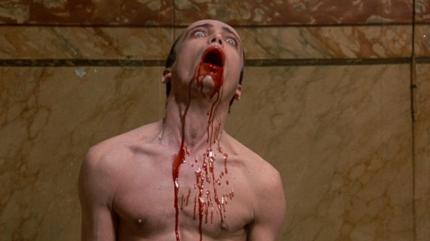 “Blood for Dracula” AKA “Andy Warhol’s Dracula” (1974) – Although there is nothing explicitly queer about the plot of this cheaply-produced French-Italian opus, the influence of director Paul Morrissey and the presence of quintessential “trade” pin-up boy Joe Dallesandro – not to mention Warhol as producer, though as usual he had little involvement in the actual making of the movie – make it intrinsically gay. The ridiculous plot, in which the famous Count (Udo Kier) is dying due to a shortage of virgins from whom to suck the blood he needs to survive, is a flimsy excuse for loads of gore and nudity. Sure, it’s trash – but with Warhol’s name above the title, you can convince yourself that it’s art.
“Blood for Dracula” AKA “Andy Warhol’s Dracula” (1974) – Although there is nothing explicitly queer about the plot of this cheaply-produced French-Italian opus, the influence of director Paul Morrissey and the presence of quintessential “trade” pin-up boy Joe Dallesandro – not to mention Warhol as producer, though as usual he had little involvement in the actual making of the movie – make it intrinsically gay. The ridiculous plot, in which the famous Count (Udo Kier) is dying due to a shortage of virgins from whom to suck the blood he needs to survive, is a flimsy excuse for loads of gore and nudity. Sure, it’s trash – but with Warhol’s name above the title, you can convince yourself that it’s art. “Phantom of the Paradise” (1974) – Again, the plot isn’t gay, and in this case neither was the director (Brian DePalma). Even so, the level of over-the-top glitz and orgiastic glam makes this bizarre horror-rock-musical a camp-fest of the highest order. Starring unlikely 70s sensation Paul Williams as a Satanic music producer who ensnares a disfigured composer and a beautiful singer (Jessica Harper) into creating a rock-and-roll opera based on the story of Faust, it also features Gerrit Graham as a flamboyant glam-rocker named Beef and a whole bevy of beautiful young bodies as it re-imagines “The Phantom of the Opera” with a few touches of “Dorian Gray” thrown in for good measure. Sure, the pre-disco song score (also by Williams) may not have as much modern gay-appeal as some viewers might like, but it’s worth getting over that for the overwrought silliness of the whole thing.
“Phantom of the Paradise” (1974) – Again, the plot isn’t gay, and in this case neither was the director (Brian DePalma). Even so, the level of over-the-top glitz and orgiastic glam makes this bizarre horror-rock-musical a camp-fest of the highest order. Starring unlikely 70s sensation Paul Williams as a Satanic music producer who ensnares a disfigured composer and a beautiful singer (Jessica Harper) into creating a rock-and-roll opera based on the story of Faust, it also features Gerrit Graham as a flamboyant glam-rocker named Beef and a whole bevy of beautiful young bodies as it re-imagines “The Phantom of the Opera” with a few touches of “Dorian Gray” thrown in for good measure. Sure, the pre-disco song score (also by Williams) may not have as much modern gay-appeal as some viewers might like, but it’s worth getting over that for the overwrought silliness of the whole thing. “The Fourth Man (De vierde man)” (1983) – This one isn’t exactly horror, but it’s unsettling vibe is far more likely to make you squirm than most of the so-called fright flicks that try to scare you with ghouls and gore. Crafted by Dutch director Paul Verhoeven (years before he gave us a different kind of horror with “Showgirls”), it’s the sexy tale of an alcoholic writer who becomes involved with an icy blonde, despite visions of the Virgin Mary warning him that she might be a killer. Things get more complicated when he finds himself attracted to her other boyfriend – and the visions get a lot hotter. More suspenseful than scary, but you’ll still be wary of scissors for awhile afterwards.
“The Fourth Man (De vierde man)” (1983) – This one isn’t exactly horror, but it’s unsettling vibe is far more likely to make you squirm than most of the so-called fright flicks that try to scare you with ghouls and gore. Crafted by Dutch director Paul Verhoeven (years before he gave us a different kind of horror with “Showgirls”), it’s the sexy tale of an alcoholic writer who becomes involved with an icy blonde, despite visions of the Virgin Mary warning him that she might be a killer. Things get more complicated when he finds himself attracted to her other boyfriend – and the visions get a lot hotter. More suspenseful than scary, but you’ll still be wary of scissors for awhile afterwards. “Stranger by the Lake (L’Inconnu du lac)” (2013) – This brooding French thriller plays out under bright sunlight, but it’s still probably the scariest movie on the list. A young man spends his summer at a lakeside beach where gay men come to cruise, witnesses a murder, and finds himself drawn into a romance with the killer. It’s all very Hitchcockian, and director Alain Guiraudie manipulates our sympathies just like the Master himself. Yes, it features full-frontal nudity and some fairly explicit sex scenes – but it also delivers a slow-building thrill ride which leaves you with a lingering sense of unease.
“Stranger by the Lake (L’Inconnu du lac)” (2013) – This brooding French thriller plays out under bright sunlight, but it’s still probably the scariest movie on the list. A young man spends his summer at a lakeside beach where gay men come to cruise, witnesses a murder, and finds himself drawn into a romance with the killer. It’s all very Hitchcockian, and director Alain Guiraudie manipulates our sympathies just like the Master himself. Yes, it features full-frontal nudity and some fairly explicit sex scenes – but it also delivers a slow-building thrill ride which leaves you with a lingering sense of unease.
















